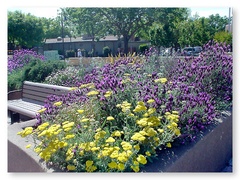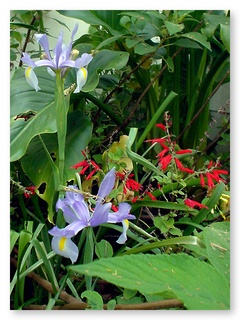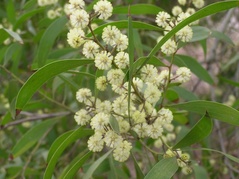Due to a variety of circumstances in Davis, both the town and campus feature a staggering array of plants, both native and exotic. Many years ago, Davis made national news when the media picked up the story that Davis' mayor had decided to plant fruit trees in all the empty lots and unbuilt areas to provide food for the homeless. Both UC Davis and the City of Davis recognize the many ways plants enrich our lives by supporting programs and concepts such as the Street Tree Program, Arboretum, planting dedications, and edible landscaping.
Some of the species planted in Davis are invasive species and could become pests in the natural environment (yes, Davis provides important habitat value for many native species). Experts recommend using them carefully, or not at all.
See the Native Plants page for the original flora that grew in Davis before Davis was Davis yet.
 Many fruit trees flower in March here.
Many fruit trees flower in March here.  Once you start noticing the plants on this page, you might also notice more beautiful things all over town!
Once you start noticing the plants on this page, you might also notice more beautiful things all over town!
Plants
Trees
 A pretty Davis tree (at the corner of Pole Line and Covell)
A pretty Davis tree (at the corner of Pole Line and Covell)  This beautiful little fan palm was found on campus One of the most prominent and impressive elements of the Davis flora is the trees. They provide habitat for the wildlife, shade, windbreaks, privacy, beauty and food for animals and people.
This beautiful little fan palm was found on campus One of the most prominent and impressive elements of the Davis flora is the trees. They provide habitat for the wildlife, shade, windbreaks, privacy, beauty and food for animals and people.
- Almond (Prunus dulcis)
- Apricot (Prunus armeniaca)
- Bay Laurel (Laurus nobilis)
- Carob (Ceratonia siliqua), an invasive.
- Cedars (includes Calocedrus, Cedrus, and Juniperus spp.)
- Cherry (Prunus spp.)
- Chinese tallowtree (Triadica sebifera (=Sapium sebiferum)), an invasive.
- Coast Redwood (Sequoia sempervirens)
- Sago Palm (Cycas revoluta)
- Elderberry (Sambucus sp.)
- Empress Tree (Paulownia tomentosa), an invasive.
- Eucalyptus (Eucalyptus spp.), an invasive.
- European White Birch (Betula pendula)
- Evergreen Pear — also known as Cumbleberry Trees because of their foul-smelling flowers.
- Fruitless Mulberry (Morus rubra)
- Hackberry (Celtis sp.)
- Various Fruit Trees
- Ginkgo or Maidenhair Tree (Ginkgo biloba)
- Goldenrain Tree (Koelruteria paniculata)
- Jacaranda (Jacaranda mimosifolia)
-
Oaks (Quercus spp.)
- Valley Oak (Quercus lobata)
- Interior Live Oak (Quercus wislizenii)
- Olive (Olea europaea)
- Palms (several genera)
- Peach (Prunus persica)
- Pines (Pinus spp.)
- Plum (Prunus spp.)
- Sycamore aka "Planetree" (Platanus spp.),
- Tree of Heaven (Ailanthus altissima)—an invasive species.
- Walnut (Juglans spp.)
- Western Redbud (Cercis occidentalis)
- Willow Trees (Salix sp.)
Visit here for a google map of fruit trees in Davis. The map is public and collaborative, so please add trees if you know of their locations. (You must have a google sign-in.) Use push-pins to mark the locations of trees. If the tree is on private property, please indicate that in the note, and only mark it after getting permission from the owner first.
Shrubs
 Have you noticed this California Lilac?
Have you noticed this California Lilac?  The Train Station has some beautiful plantings, in this picture you can see lavender and yarrow blossoms.
The Train Station has some beautiful plantings, in this picture you can see lavender and yarrow blossoms.
- Angel's Trumpet (Brugmansia sp.)
- Brazilian Plume Flower (Justicia carnea)
- California Lilac (Ceanothus spp.) — some species can be considered small trees
- Cashmere Bouquet (Clerodendrum bungei)
- Crape Myrtle (Lagerstroemia indica) — also considered a small tree
- Flowering Maple (Abutilon sp.)
- Flowering Quince (Chaenomeles sp.)
- Fuchsia (Fuchsia spp.)
- Lavender (Lavandula spp.)
- Lilac (Syringa vulgaris)
- Orchid Rockrose (Cistus purpureus)
- Paraguay Nightshade (Lycianthes rantonnetii)
- Plant Man ("Phytovir") — not the cold sore medicine
- Pride of Madeira (Echium candicans)
- Privet (Ligustrum spp.) — also considered a small tree, an invasive.
- Rose Mallow (Lavatera trimestris)
- Rosemary (Salvia rosmarinus)
- Sage (Salvia spp.)
- Stonecrop (Sedum spp.)
Vines
- Trumpet Vine (Campsis radicans)
- Grapes (Vitis spp.)
Flowers
 An early tea rose of spring!
An early tea rose of spring!  Calla lilies are one of Davis' early arrivals each year.
Calla lilies are one of Davis' early arrivals each year.  A red-lipped salvia brushes up against iris in this little corner.
A red-lipped salvia brushes up against iris in this little corner.  A nature-made bouquet.
A nature-made bouquet.
-
Aroids
- Caladium (Caladium)
- Calla Lily (Zantedeschia aethiopica), an invasive.
- Dragon Lily (Dracunculus vulgaris)
- Elephant's Ear aka Taro (Colocasia esculenta)
- Flamingo Flower (Anthurium scherzeranum)
- Jack in the Pulpit (Arisaema triphyllum)
- Tabatha the Titan (Titan arum)
- Bad Man's Plaything (Achillea spp.)
- Fiddlenecks (Amsinckia spp.)
- Begonias (Begonia spp.)
- Bacopa (Sutera cordata)
- Bellflowers (Campanula spp.)
- California Golden Poppy (Eschscholzia californica)
- Coral Bells (Heuchera spp.)
- Evening-Primrose (Oenothera spp.)
- Fleabane (Erigeron spp.)
- Foam Flower (Tiarella cordifolia)
- Four O'Clock (Mirabilis spp.)
- Freesia (Freesia corymbosa/refracta/laxa)
- Geranium (Pelargonium spp.)
- Globe Artichoke (Cynara scolymus)
- Hollyhocks (Alcea rosea)
- Iris (Iris L.)
- Jupiter's Beard (Centranthus ruber)
- Lantana (including L. camara)
- Lenten Rose (Helleborus orientalis)
- Lupines (Lupinus spp.)
- Madwort (Lobularia maritima)
- Maiden's Wreath (Francoa sonchifolia)
- Marigolds (Tagetes species)
-
Mints (Lamiaceae)
- Bugleweed (Ajuga reptans)
- Cashmere Bouquet (Clerodendrum bungei)
- Dead Nettle (Lamium maculatum)
- Lemon Balm (Melissa officinalis L.)
- Sage (Salvia)
- Money Plant (Lunaria)
- Naked Lady (Amaryllis belladonna)
- Naples Onion (Allium neapolitanum)
- Nasturtium (Tropaeolum majus)
- Oriental Poppy (Papaver orientale)
- Periwinkle (Vinca major)
- Peruvian Lily (Alstroemeria hybrids)
- Pig Squeak (Bergenia cordifolia)
- Primroses (Primula species and hybrids)
- Roses (Rosa spp. and hybrids)
- Spring Flowers
- Spring Snowflake (Leucojum vernum)
-
Succulents
- Aloe (Aloe L.)
- Century Plant (Agave L.)
- Fairy Crassula (Crassula multicava)
- Sweet Woodruff (Galium odoratum)
- Violets (Viola spp.)
- Western Columbine (Aquilegia formosa)
- Wood Sorrel (Oxalis spp.)
Foliage Plants
- Baby Tears (Soleirolia soleirolii)
- Bamboo (mostly Phyllostachys (running) and Bambusa (clumping) species and cultivars)
- Comfrey (Symphytum officinale)
- Dwarf Mondo Grass (Ophiopogon japonicus)
- Oregano (Origanum vulgare)
-
Ferns
- Boston Fern (Nephrolepis exaltata)
- Maidenhair Fern (Adiantum capillis-veneris)
- Lamb's Ear (Stachys byzantina)
Weeds & Parasites
 Food, flower or weed... it's all a matter of perspective; a field of mustard in town.
Food, flower or weed... it's all a matter of perspective; a field of mustard in town.
- Bindweed (Convolvulus arvensis)
- Devil's Claw (Proboscidea spp.)— Aggie column
- Dandelion (Taraxacum officinale)
- Filaree (Erodium moschatum)
- Gopher Weed (Euphorbia lathyris)
- Johnson Grass (Sorghum halepense), an invasive.
- Mistletoe (Phoradendron macrophyllum)
- Mustard (Brassica alba), an invasive.
- Sticky Weed (Galium aparine)
- Thistle (several genera, including Carduus, Cirsium, and Silybum)
- Wild Oats (Avena fatua)
- Wood Sorrel (Oxalis spp.)
- Yellow Oxalis (Oxalis pes-caprae), an invasive.
- Yellow starthistle (Centaurea solstitialis), an invasive.
Poisonous Plants
Many plants have compounds in them that are skin irritants, or are harmful if ingested. Yet other plants cause allergies to some people. Below are some of the most notable chemically irritating plants found in Davis. Some are native, some are not. Mind you, lots of commonly eaten plants have toxic parts—many of the plants related to cherries have poisons in their pits. The list below is certainly not a complete one. If you think you are suffering from some kind of plant poisoning, contact Poison Control (1-800-876-4766). Also refer to this really helpful plant toxicity guide.
If you are a gardener that has a yard filled with interesting horticultural introductions, you might have a whole apothecary in your back yard. If you have children, you ought to cross-reference the names of the plants in your garden against a good list of toxic plants. The Western Garden book may provide that information.
If you have pets, you need to be aware of which plants in your garden or home are toxic to pets. UC Davis' Center for Companion Animal Health has a helpful web page http://www.vetmed.ucdavis.edu/ccah/health_information/plants_pets.cfm.
- Angel's trumpet (Brugmansia sp.)—a beautiful horticultural tree, highly toxic.
- Chinaberry (Melia azedarach)—berries and other parts of the tree are poisonous to humans and probably dogs as well, although not to birds.
- Delphinium (Delphinium spp.)—also called larkspur, highly toxic.
- English Ivy (Hedera helix, Hedera canariensis)—absolutely harmless to most, but some people can develop limb-bloating allergic reactions on contact.
- Foxglove (Digitalis purpurea)—a beautiful horticultural plant, highly toxic.
- Lilies (Lilium spp.)—all species of lilies are toxic, including Easter lily and Lily of the Valley (Convallaria majalis). Cats are especially sensitive and sadly quite a few cats die each year from ingesting household lilies.
- Lupines (Lupinus spp.)—the seeds, which look like edible beans, are attractive to children.
- Morning glory (Ipomoea spp.)—do not eat this plant's seeds.
- Oleander (Nerium oleander)—all parts of the plant are toxic. Do not use its branches for roasting marshmallows or hot dogs! The white latex can cause skin irritation.
- Poison hemlock (Conium maculatum)—the plant that killed Socrates. Ingesting this very common weed can be deadly in large amounts.
- Poison oak (Toxicodendron diversilobum)—depending upon the person, the active ingredient (urushiol), ranges from harmless to dangerous. Sensitivity to poison oak is an allergy.
- Sago palm (Cycas revoluta)—all parts of the plant are poisonous and ingestion can be fatal. Don't wait for symptoms to appear. If you think a child or pet has eaten the seeds or leaves, call your doctor or veterinarian right away.
- Tree of Heaven (Ailanthus altissima)—an invasive species that is mildly toxic (but that smell! Who would eat it?), and can cause skin rashes.
- Tree tobacco (Nicotiana glauca)—occasionally encountered as a roadside weed.
- Yarrow (Achillea millefolium)—mildly toxic, also it can cause skin rashes.
Other Plants and Fungi
Agriculture
Resources
 Blossoms on a Blackwood Acacia (Acacia melanoxylon) in the Arboretum
Blossoms on a Blackwood Acacia (Acacia melanoxylon) in the Arboretum
- a list of local Nurseries
- a list of local Tree and Landscaping services
- a list of florists
- Valley-Wise Garden aka Ruth Risdon Storer Garden — a well-labelled demonstration garden
- Arboretum Terrace — on the east side of Davis Commons. A little gated public garden that features a variety of plants native to the Central Valley. The idea is to provide a model for sustainable, drought-tolerant landscaping in Davis.
- UC Davis Arboretum — includes examples of many native plants.
- UC Davis Botanical Conservatory — just north of Hutchison Hall; home to Tabatha, the giant corpse flower. Greenhouses are open to the public, and many of the botanists on hand are glad to answer questions. (Website)
- Environmental Horticulture Club
- California Native Plant Society, Sac Valley Chapter
- Campus Tree Walk
- Garden of the Ladyes Shakespearean Rose Garden — in Voorhies Hall courtyard. There's a box with pamphlets that lead you, via Shakespeare trivia connected to each rose variety, around the garden.
- Plant Toxicity Guide
- California Invasive Plant Council
- Davis Garden Show — a call in radio show on KDRT
* Stylistic note: I'm listing specific tree/plant names in singular form and groups of trees/plants in plural. Agreed? -Eric
Ok, it has been quite awhile since I took 7th grade science, so I might be a bit fuzzy on this. Flora refers to plants. Mushrooms are not plants. They are fungus. Should they be on this page? -WilliamLewis
- Flora and fauna are the two original classifications. Flora refers to all non animal lifeforms, including bacteria (and mushrooms). Fauna refers just to animals. Check a dictionary or Pliny's bestiary for more. — jw
- To split hairs on lineages, fungi are more closely related to animals, than to plants. This is why treating fungal problems in ag and medicine is difficult; most anti-fungal treatments turn out to also be quite harmful to us. — MatthewTom
2008-09-05 08:29:13 I'm having trouble with the figure alignment on this page. Notice the unwanted white space. How is this handled? —BarryRice
2010-03-27 08:16:03 Using the symbol == forces a break in a page. The SUBHEADINGS on this page are "== TITLE ==" which forces the text to drop below ALL images before continuing. So, since the mushroom picture is taller than the text in that section is long, there was a gap there. I moved the image down a bit (because the next section is longer) and that looks a little better. —LoisRichter
2011-05-02 13:24:56 Under toxic plants it says "morning glory - do not eat these seeds". But morning glory isn't really a strong poison, it is a poison that makes you hallucinate and people sometimes take these seeds to trip, similar to taking shrooms or acid (LSD). These plant seeds may also give you tummy aches as you trip, unless you go through a long process that gets the "bad" stuff out of the seed.
2012-05-11 20:38:53 A list of plants toxic to pets can be found on the UC Davis Center for Companion Animal Health web site: http://www.vetmed.ucdavis.edu/ccah/health_information/plants_pets.cfm





Comments:
You must be logged in to comment on this page. Please log in.